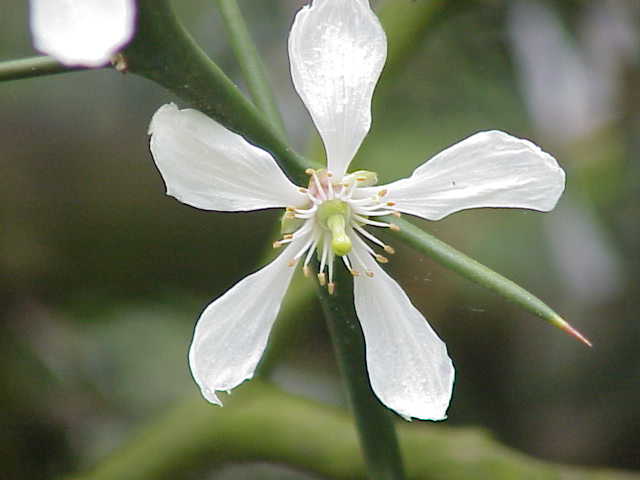Chapter 119 Poncirus trifoliata
119.1 Hardy orange
A mature shrub. Hardy oranges form loose open shrubs with leaves divided into 3 leaflets. Link to original image.
119.2 Soil: General Deciduous / Rich Conifer Mix
Ratio: 3 parts bark, 1 part grit
Add-ins: dolomitic limestone (~5 lbs/yd), Tree-Tone (15 lbs/yd)
pH: ~6.5 (slightly below neutral)
Moisture: average.
119.3 Light
Routine: does best in full sun, but can tolerate some shade.
119.4 Cultivation Notes
This is an experimental species. Most of what I know comes from the Missouri Botanical Garden Plant Finder. It is often planted as a hedgerow shrub; the thorns make it impossible to penetrate. Yellow fruits hang on into winter.
119.4.1 Potting & Root Pruning
I have repotted in later spring once the frost date passes.
119.4.1.1 Top & Branch Management
I’ve done most of the pruning in the spring. Generally recommended to wait until after flowering to prune. Spiny, dark green stems require 2-3 years to develop woody bark. Be careful pruning; the thorns are vicious.

Single flowers of hardy orange appear in late spring. Link to original image.
119.4.2 Feeding
I have been feeding on the same schedule and with same materials as Japanese maples.
- Slow release shrub and tree fertilizer, applied at half the recommended rate.
- Organic plant food that must be broken down by soil microbes, such as fish emulsion or Epsoma Tree-Tone.
- Inorganic, water soluble fertilizers at half strength rather than full strength.
119.4.3 Pests & Problems
No serious insect or disease problems. Thorns are vicious.
119.4.4 Winter Storage
Store in mulch outdoors. Try to place in a shaded area so buds do not break in a mid-winter warm spell. No other special precautions are needed in Zone 7-8. Not winter hardy in Zone 6.
119.5 Propagation Notes
Seeds extracted in fall from fruits can be dried for 2-3 days and stored refrigerated then planted in trays in spring.
119.6 Artistic & Styling Notes

In late summer large numbers of golf ball-sized fruits form. These are very seedy and sour, like key limes. Link to original image.
Close view of two fruits. The fuzzy fruits are born on extremely sharp thorny branches. Link to original image.
Foliage is sparse, so do not try to ramify. Shoot for general foliage outline.
119.7 Additional Information
119.7.1 Natural History
Hardy orange is native to China but has escaped cultivation and naturalized widely. It is used as grafting rootstock for other citrus, and likely escaped when grafts sprouted from roots or the top scion failed, and the rootstock fruited instead.
119.7.2 In Cultivation
Grows from 8-20 feet high, 6-15 feet wide. The white blooms appear in April or May and are fragrant.
Three-lobed leaves emerge yellowish-green in spring, turn glossy dark green in summer and fade to yellow in autumn.
Seedling plants will develop large trunks if left in the ground for several years, so woody development IS possible, but I do not have enough time with it yet to say much more.

